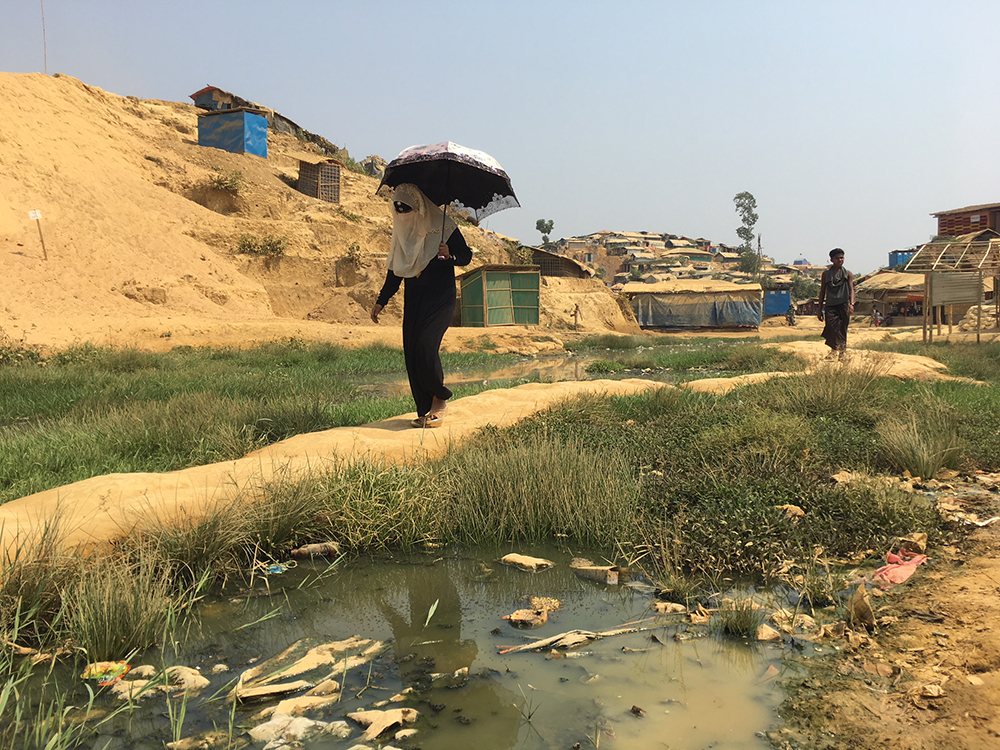COX’S BAZAR, BANGLADESH. On a barren hilltop in the Balukhali refugee camp, not far from the border he crossed seven months ago, Muhammad Eleas has a panoramic view of what many consider a disaster waiting to happen. “When the rain comes,” he says, “everyone living here will suffer.”
Mr Eleas, 63, is one of an estimated 700,000 Rohingya refugees to have arrived in Bangladesh since violence against Myanmar’s Rohingya minority worsened in August last year. There are so many of them in the Kutupalong-Balukhali complex – the “megacamp,” as it is informally known – that it is technically the fourth largest city in the country.
It is a city built on a trauma. Mr Eleas, who lives in Balukhali with his wife and son, fled his home in Buthidaung township as soon as the military arrived with its scorched-earth policy, which the UN has described as ethnic cleansing. “They began slaughtering people and burning down homes. People were rounded up into mass graves and shot,” Mr Eleas says. “We were very lucky to escape.”
Over the next seven days, the Myanmar military pursued his family and others towards the border. He recalls a mad dash across the Naf River, which separates the two countries. “They were shooting at us even as we ran down to the water,” he says. Sitting on the floor of his one-room shack, the earth beneath him cracked and dry, he holds up his fingers to resemble a machine gun.
The human tragedy of the Rohingya crisis has been matched only by the ecological one that has attended it. What used to be densely-forested hill tracts have been clean-shaven and carved into terraces. Makeshift dwellings of bamboo and sheet plastic sit immediately above one another on slopes of silt. All this is likely to turn to mud as soon as the monsoon season arrives. When a brief but heavy downpour occurred last month – a mere taste of what is likely to come – aid workers reported that parts of the camp had become a “quagmire”.
Mr Eleas shows me his personal set-up: an assortment of sandbags set against a cut in the hill that drops off less than a metre from his door. “I need more, but they’ve all been given out and we’ve been told that we’re not going to get any more,” he says. For the time being, the bags are being held in place by a collection of wooden stakes. “But they won’t hold under heavy rain,” he says, bending one back to demonstrate how useless it is. He looks down the hill at the shelters below him. Were his own home to come unmoored in a mudslide, it would take out several others with it.
For Sabekun Nahar and her family, the season poses other threats. Ms Nahar, 27, lives with her husband, Sobbir Ahammed, at the bottom of one of the camp’s many hills. The tale of their flight from Myanmar echoes Mr Eleas’s own, though in their case they had six children, aged between six months and eleven years old, in tow.
“We carried the children for eight days,” Ms Nahar says. “My legs became swollen. The older ones understood what was going on and still have nightmares about it. The younger ones ask when we’re going to go home.”
In addition to mudslides from above, Ms Nahar is also worried about the lack of drainage below. “There is nowhere for the rain to go,” she says. “A lot of people on this level are worried that our homes are going to be washed away by floods. It’s very worrying, because there are a lot of families with small children on this level and floods can bring diseases.”
A higher vantage illustrates the problem. From Balukhali’s road, which runs along a series of high ridges, the blocks into which the camp is divided resemble nothing so much as catchment areas. The shallow ditches that run up and down what passes for streets here do little to inspire confidence. Approximately 80 per cent of Bangladesh’s annual rainfall occurs between June and October. A study carried out by Dhaka University and the UN refugee agency suggests that up to one-third of the settlement area could be flooded.
Mr Ahammed, 30, says there’s little the family can do but wait. “We don’t have the materials we need to prepare,” he says.
While Mr Ahammed is sure there are aid organisations working on the problem, it’s difficult to know for sure. “No one has come to speak to us,” he says, and all information is second or third-hand by the time it reaches them. “It’s difficult to know what’s going on.”
Ms Nahar has an even harder time of it. “I’m a woman,” she says. “We don’t get told anything.”

Photography by Matthew Clayfield
Preparing for the worst
The camp’s residents may not always be aware of it, but the race to weatherproof their new home has been under way for several months. The UN Refugee Agency has relocated more than 380 families living in flood-prone areas since February and is planning to distribute ‘pre-monsoon’ kits consisting of strong rope, steel pegs and cement sandbags to families in its operational areas by the time the season arrives.
But as the UNHCR’s Caroline Gluck admits: “It will be very challenging to relocate all the ‘at risk’ population given the current circumstances. We are preparing for the worst [and] hoping for the best.”
The problem was and remains the availability of land. When a refugee crisis of this magnitude hits, the immediate priority is to make sure people have places to live, even if that means building on hillsides and floodplains that may become dangerous later on.
“At the start of the influx … families had no choice but to build shelters where they could find empty space,” Ms Gluck says. “Now they are at high risk of losing their shelters – especially if [they live on] slopes of 45 degrees or more.”
Lack of land also makes large-scale relocation difficult: there’s simply not enough space to move people. In February, the Government of Bangladesh promised an additional 500 acres of land for the UNHCR and the International Organisation for Migration to develop. The former has already started work on its own 123-acre patch. “Even so,” Ms Gluck says, “this site can only house around 12,000 people.”
As a result, mitigation remains the order of the day. “Slopes are being stabilised, pathways reinforced, drainage improved, new bridges put up, and refugees are being provided with stronger, more waterproof shelter kits,” Ms Gluck says. “Early warning systems are being prepared and many refugees are being trained as safety unit volunteers. Bangladesh – which has vast experience in dealing with cyclone events and preparedness – has also extended its national Cyclone Preparedness Programme to the Rohingya settlements so that refugees can be trained in early warning, search and rescue, and relief.”
Organisations like Médecins Sans Frontières are also ramping up their efforts in anticipation of the rains, with outbreaks of water-borne diseases such as cholera and Hepatitis E of particular concern. But MSF’s emergency coordinator in Cox’s Bazar, Sam Turner,”says that limited infrastructure means that only so much can be done.”
“Access to safe drinking water and sanitation services is already insufficient,” he says. “[These are] often of poor quality and unequally distributed throughout the camp.”
“The situation will be exacerbated by rains and floodwater, which can cause latrines to overflow and contaminate water sources. Standing water across the camp could also serve as breeding grounds for mosquitoes, a common vector for disease.”
Mr Turner says that MSF has ten health posts, four primary healthcare centres and five inpatient facilities spread throughout the camps, which will bear the brunt of monsoon-related health scares.
It is difficult not to see the situation as one of rolling crises in which short-term solutions pave the way for future problems. “We must be clear that [the monsoon season] is not an isolated issue,” Mr Turner says. “The living conditions in the camps themselves expose the Rohingya to [these problems].” One wonders how aid organisations manage to plan for the long-term while battling a constant stream of pop-up issues.”
“[We need to ensure] long-term funding so that we can continue to provide basics like food, clean water, health facilities and healthcare,” Ms Gluck says. “We need to extend learning facilities for children who currently do not access any schooling, work to decongest the camp, run protection programmes for single mothers and unaccompanied or separated children, and so on.
“We hope that lessons learnt from this monsoon season will inform our planning moving forward.”

Photography by Matthew Clayfield
The strongest house in Balukhali
Not everyone is content to wait for assistance. A short walk from Ms Nahar’s flood-prone dwelling, past the makeshift school her children attend, Ruhul Amin and a group of men are erecting the bamboo frame of a new home. They’re trying something new, they tell me: tarpaulin walls instead of the usual plastic sheeting. “There aren’t many houses built like this,” Mr Amin says proudly.
He leaves the means by which the tarpaulin has been procured deliberately vague. When asked whether they’ve heard anything about refugees trading aid packages for materials they can’t usually get their hands on – World Food Program packages have been photographed in a number of Cox’s Bazar markets – the men shake their heads in vigorous unison. When it is explained to them they’re not being accused, only asked if they’ve been privy to rumours, one of them admits, a little sheepishly: “I have heard that some people do this thing. But not us!”
Mr Amin, 41, says the house is being built with the monsoon season in mind. “This settlement was built in the dry season and is only suitable for the dry season,” he says. “You can see that this house is above the floodline and isn’t at risk from those on the hills.”
He doesn’t come across as an excitable man – he seems more weary than anything – but brightens considerably when asked about the tarpaulin’s unique properties. “Last night was windier than any night since we arrived,” he says. “Many people’s walls were torn to pieces because the plastic is too thin.” The first of Bangladesh’s two annual cyclone seasons began in earnest in March and will continue until July. The latter takes place between September and December.
“Everything will only get worse with the rains,” Mr Amin says. “Houses will leak. Roofs will collapse. This house will be stronger than the others.”
Strong enough to see out the year? An elderly woman has been listening to our conversation, squatting in a nearby doorway. She begins to laugh, shakes her head, and disappears back into her dwelling. Mr Amin shrugs.
“I’m not sure that any structure in Balukhali will be strong enough for that,” he says.






